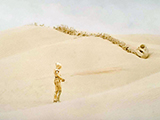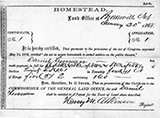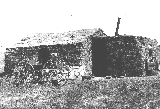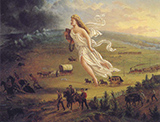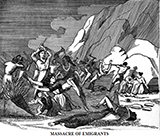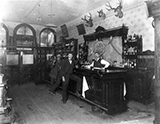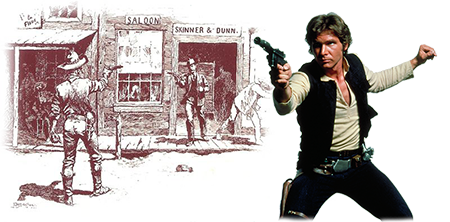
The story of Westward expansion in the United States is reflective of the European discovery and conquest of the New World. Both are tales of hope and promise, but also great tragedy and destruction. By the late 1800’s, America was ready to break out into the unknown territories beyond the Appalachian Mountains. Because of earlier exploratory missions like that of Lewis and Clark, it was known that tremendous amounts of wealth and resources awaited those who could find and claim them. All it would take was the right time and proper incentives. Similarly, parallels can be drawn to the frontiers of Tatooine, the home world of Anakin and Luke Skywalker.
In Star Wars, similar themes and circumstances to those which faced America's pioneers can be seen. When Tatooine is first shown in Episode IV it becomes quickly evident that C-3P0 and R2-D2 have landed on a desolate and dangerous planet. At one point the giant Krayt Dragon skeleton is visible in the distance, a reminder that one could become the prey of this fearsome animal or possibly end up a dried out skeleton in the desert. For fans who have viewed this scene so many times, it is easy to forget the sense of danger and unknown that George Lucas was trying to convey. As Artoo ventures through that empty canyon alone with prying eyes and strange noise everywhere, it is difficult to fear for him. Those who have seen the movies know the Jawas won’t hurt him and that he and C-3P0 will both be sold to Luke’s family. The next time this scene is viewed, try to imagine the feelings of the droids and think of the pioneers who ventured westward despite danger lurking around every corner, just as it did for Artoo and Threepio.
The Jawas can be loosely connected to traders who traveled around the “old west” selling their wares to homesteaders and the like. Just as the Jawas sometimes did, not all of the items sold were obtained legally. When the Jawas found the droids, they were fair game. R2-D2 and C-3P0 were all alone and had no clear marks of identification. The Jawas took them knowing it would be difficult for anyone to prove ownership in the future. After capturing the droids, the first thing they did was fit them with restraining bolts to keep them from running away. Another ulterior motive of using the restraining bolts was to mark the droids as their property. This is reminiscent of cattle farmers and cowboys branding their cows. In the days before barbed wire, cattle could roam freely and would scatter into other people’s lands. The lack of property lines also made it easy for other cowboys to simply merge the cattle belonging to others into their own herds (sometimes it was an honest mistake). Without an identifying mark, it was nearly impossible to recognize one’s own cattle. The result of all of this was branding. A brand is an iron mark, usually the initials or symbol representing the owner, which is heated to a high temperature and then placed on the hide of the cow. The owner’s symbol is then burned into the cow’s hide, marking it forever as his. Now, if a cow is stolen or becomes lost, it would be easier to claim and prove ownership, just as the Jawas could with their restraining bolts.
Finally, the Jawas arrive at Luke Skywalker’s home, the Lars Homestead. It’s not a coincidence that George Lucas chose to use this term. He is making a clear reference to the homesteaders who braved the dangers and settled the unknown territory of America’s West.
It’s hard to imagine being one of the brave pioneers who left behind everything and everyone they knew to venture into a mysterious, but promising land. They understood that hardship would be around every corner, but all of the struggles would be worth it in the end. Following the Louisiana Purchase of 1803, Americans began to move slowly westward. It wasn’t until after the Civil War, though, that people began flocking Westward by the thousands. What motivated them to go then and not earlier? In 1862, President Abraham Lincoln signed the Homestead Act, which promised land (for free or at little cost) to those wishing to claim it. Homesteaders were required to file an application and meet the following criteria to receive their 160 acres:
- Have never taken up arms against the United States
- Be 21 years or older or the head of a family
- the land had to be improved and lived on for a total of 5 years
At the conclusion of the five years, the applicant could file for a deed and be granted ownership of the land. Between 1862 and 1934, the US government granted a total of 1.6 million homesteads totaling over 400,000 square miles of land. In the end, roughly 40% of all applicants would fulfill the Homestead obligations and earn their land deeds.
The life of a homesteader was extremely difficult. One must remember that this was a time before supermarkets and convenience stores were around every corner. Those who took the risk of moving west faced great adversity. Neighbors could be miles away and difficult to reach. Again, remember that the absence of phones, cars, and even trains at this time made life in the west less than desirable. Each homestead had to support itself. Often, this was easier said than done. Many homesteaders found their land hard to cultivate due to poor soil or lack of tools to farm appropriately. If one’s land was missing a water source like a stream or river, survival became that much more difficult. Tornadoes and floods would also challenge the resolve of these brave adventurers.
Homesteaders on Tatooine found similar difficulties, the most obvious being the lack of water and presence of extreme heat. The purpose of the homestead was to farm moisture for Luke and his family, but also the residents of Tatooine in general, just as the farmers of the Midwest supply wheat and grains to Americans today. In fact, the Midwest is considered the “bread basket,” meaning that most of America’s and much of the world’s grain supplies come from there. Life as it is known today would not be possible without the large amount of farming that takes place in the Midwest. On Tatooine, farmers collect water from the planet’s atmosphere using moisture vaporators. These vaporators are seen in the films as the tall, white towers scattered around the desert surface. Without these brave homesteaders venturing into the desert to collect the precious water, life on Tatooine would be nearly impossible.
Most homesteaders in western America found few trees out in the open plains of the Midwest. With practically no building materials available, they turned to sod as a building material for their homes. Sod is essentially large chunks of soil cut out of the ground and stacked similarly to bricks. Home life was, at times, dreary and depressing and it can be assumed that many homesteaders probably wondered what they had gotten themselves into. It’s these kinds of hardships that should make Americans appreciate and respect what their country is today.
Similarly, the homesteaders of Tatooine also discovered few building materials in their desert world. Rather than building their homes on the planet’s surface, they dug deep into the ground, creating subterranean dwellings. Entrenched deep below the surface, these homes provided the perfect refuge from the harsh desert heat and dangerous sand storms.
After R2-D2 runs away in search of the mysterious Obi-Wan Kenobi, Luke mentions that it’s too dangerous to look for him that night because of all the Sand People. The next morning, Luke and C-3P0 set off in search of their lost friend and locate him deep within the Junland Wastes. As they round him up, R2 alerts them to the presence of strange creatures approaching. Luke quickly grabs his binoculars and discovers that Sand People (also known as Tusken Raiders) are upon them. He watches them with fear, but also a sense of fascination and curiosity. At that moment, two Raiders appear and viscously attack Luke and his party. An unconscious Luke is dragged to his speeder and then left as the Raiders begin tearing apart his ride, scavenging for goods. Finally, Obi-Wan appears and scares the Tusken Raiders away.
Tusken Raiders are among the indigenous people of Tatooine. They have survived on this planet for thousands of years along with Jawas and other native peoples. Sand People are known for their raids on human settlements and even the small cities of Tatooine, like Anchorhead. Due to failed interactions with humans, Tuskens viewed them as dangerous and used violence and fear to keep them away. Naturally, the Tuskens and their use of primitive weapons like Gaderffii sticks made it easier for settlers and their more technologically advanced weapons to keep the Raiders at bay. Of course, the Tuskens were misunderstood to some degree. Sure, they would act violently towards outsiders, but it was because their land and way of life was being threatened by these careless outsiders and their technologies.
Another danger of venturing westward in America were the Native Americans. At the time, they were unfairly viewed as savages and inferior beings, much like the Sand People of Tatooine. Americans believed it was their duty to move into Native territory. After all, the Natives dressed in skins and hunted with bows and arrows. Americans represented the modern world of progress with guns, trains, and vast cities. They believed it was their “manifest destiny” or duty to move westward and bring their great civilization and modernism to these so-called savages. For many, this idea of manifest destiny justified the removal of the Natives from their lands. It was believed that the Natives should adapt to the modern ways or simply be removed or die off. This same imperialistic idea of social Darwinism or “survival of the fittest” would later fuel the “scramble for Africa” that would eventually contribute to the destruction of many African peoples and cultures.
The idea of social Darwinism was most certainly hypocritical. From the beginning, little regard was given to the Native's way of life and the lands that they had occupied for hundreds, if not thousands of years. Americans used progress as their argument and tool to remove Natives justifiably. Occasionally, treaties were made where Native populations were promised land elsewhere. In most cases, the land they were moved to was poor and not suitable for sustaining life. Even then, many Natives would be removed from these lands later. If Natives failed to accept the terms of a treaty, they would be forcibly removed. The most notable of these events occurred in 1830 with the Indian Removal Act, which led to what history remembers as the “Trail of Tears.”
On their way to Anchorhead, Luke and Obi-Wan stumble across the dead bodies and destroyed Sandcrawler of the Jawas who sold them Artoo and Threepio. Lifeless Jawas are scattered everywhere, the Sandcrawler has been looted and torched, but tell-tale signs of the attackers remain. Luke points out the presence of Gaderffii sticks and Bantha tracks, indicating that Sand People are responsible for the attack. Obi-Wan sees through the illusion and points out that Imperial Stormtroopers murdered the Jawas and created a scene to resemble a typical Tusken Raider attack.
Although the attack was not carried out by Tuskens, the scene is reminiscent of the American pioneer's greatest fear, an attack by the Natives. It wasn't very common, but Natives would sometimes ride in and attack a passing wagon or group of travelers unexpectedly. Later on, passersby would find the remains of the wagon and its occupants. It was certainly a gruesome scene and one that sent a clear message to the encroaching settlers.
Naturally, hostilities between the encroaching Americans and the Natives increased over time, resulting in the so-called Indian Wars of the late Nineteenth Century. Native leaders like Geronimo and Sitting Bull have become icons for their heroic fight to preserve their lands and way of life. Homesteaders had reason to fear the Natives, but the modern interpretation that the Natives were openly hostile to pioneers is somewhat exaggerated. Still, Natives would occasionally attack small numbers of pioneers in their settlements or as they travelled.
In the end, technology would prevail over the Natives and they would lose nearly everything. Today, many Natives live on reservations and continue their lives and traditions as best they can.
As homesteads became more common, the railroads were expanded westward and small towns began popping up all over western America. Many of these towns like Dodge City or Deadwood became infamous for their lawlessness and danger. One of the common areas for trouble was the local saloon or cantina where ruffians, gamblers and cowboys would hang out after a hard day’s work. Several shots of whiskey and a bad hand of poker later, fighting would often erupt. Guns were typically involved, but the concept of the high noon showdown is more of a Hollywood creation than a historical reality. Although gunfights were common, they were often spur of the moment and involved numerous shots fired… often hitting innocent bystanders. Regardless, saloons were dangerous places and one had to certainly tread lightly if they chose to enter and quench their thirst.
On Tatooine, Mos Eisley is the stereotypical Wild West town with Obi-Wan saying it is a place where “you will never find a more wretched hive of scum and villainy.” True to his word, Obi-Wan, Luke and his friends are met with little welcome as they enter the cantina. Within minutes, two dangerous encounters occur. First, Luke was confronted by Doctor Cornelius Evazan and his loyal sidekick, Ponda Baba. This encounter ended with the latter losing an arm to Obi-Wan’s lightsaber. The second fight occurred minutes later when Han Solo was stopped by the bounty hunter, Greedo. After a brief conversation, Greedo fired his blaster at Han, missing his mark with deadly inaccuracy. In classic western style, Han calmly gets up, tosses a coin to the bartender and apologizes for the mess.
The use of Western themes is common throughout the Star Wars saga. In Episode II, it is revealed that Anakin’s mother, Shmi, has been kidnapped by the Sand People. In an act of love and revenge, Anakin sets out to find his mother. In the end, he locates her but it is too late and she dies in his arms. Filled with rage, Anakin ruthlessly murders the entire tribe of Tuskens, giving no regard to women or children. Anakin never stops to ponder why the Sand People took his mother or why they constantly fight with the settlers of the planet. His answer to the problem is one that will come to dominate his purpose, to wipe out all who stand in his way. In fact, Anakin’s choice to murder the Tuskens is reminiscent of his future mentor, Darth Sidious, who had said of the Naboo, “Wipe them out… all of them.”
Studying the Westward Expansion of America is an integral part of teaching US History. Typically, educators find that students have a difficult time finding relevance with the difficulties faced by the pioneers or the tragedy of the Native Americans. Like so many historical concepts, events of long ago mean little to students. By connecting history to Star Wars, a teacher not only provides students with a visual representation, but also an emotional connection to the past. Examining history through the eyes of Luke Skywalker or other Star Wars characters will help students realize their own appreciation and understanding of history.
Luke Skywalker, Tatooine, Lars Homestead, Jawas, Sand People, Mos Eisley Cantina
- Homestead Act Primary Documents
- About the Homestead Act
- Homesteading Documentary
- Dangers of the Trail in 1865 by Charles E. Young
- American Indian Wars
First posted on: January 31, 2013 by Wes Dodgens
